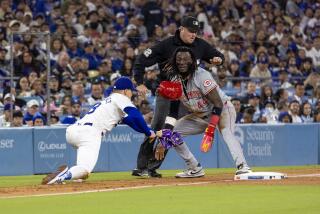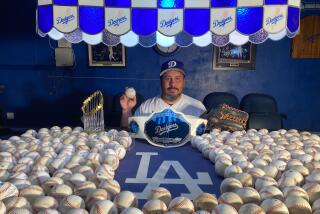Some of Baseball’s Best Thieves Have Done a Peach of a Job : Gamesmanship: For Charlton’s edification, sign stealing has been going on forever and is part of the lore of the game.
- Share via
Even now, 40 years later, Gene Mauch remembers distinctly the peach nectar can--empty and large enough to be seen in a window of the center-field clubhouse at New York Polo’s Grounds, more than 500 feet from home plate.
Watching from the window and using binoculars to steal the catcher’s signs, Mauch would place the can on the left side of the sill if the pitch was going to be a curveball, on the right side if it was going to be a fastball and in the middle if it was going to be a changeup.
“I remember one game when Walker Cooper was catching and Dave Koslo was pitching (for the Giants) that I called every pitch,” said Mauch, then a utility infielder with the Chicago Cubs. “I think we got three hits and one run.”
Mauch’s semaphores may not have helped his team’s batters, but that’s not the only message here.
The subject is sign stealing, a common practice long before Norm Charlton was born, and a practice common enough since that Dodger broadcaster Don Drysdale, reached in Houston Wednesday, said of the Cincinnati Red pitcher:
“The guy has three degrees from Rice University, but none of them could be in baseball. He should have a meeting with his manager and find out what the game is all about.”
Said Angel Manager Buck Rodgers: “I’ve always tried to warn my pitchers (about having signs stolen), but a lot of times they’re too stupid or too lazy to use a more complicated system.
“This guy (Charlton) is just making an excuse for getting his . . . ripped. I mean, there must be something in the Cincinnati water, because he’s about the third player of theirs who has opened his mouth and inserted his foot.”
Charlton said he intentionally hit Dodger catcher Mike Scioscia with a pitch Monday night because Scioscia was stealing signs from second base.
“He’ll be lucky if I don’t rip his head off the next time,” Charlton said.
Mauch, a major league manager for more than 25 years and an honor student long before that, laughed at Charlton’s comments and called them “an absolutely stupid overreaction” by a guy who doesn’t seem to know anything about his business and how it’s transacted--or used to be, at least.
“Stealing signs was as much a part of the game as the hit-and-run, and there were more guys better at it than at the hit-and-run,” Mauch said from his home in Rancho Mirage Wednesday.
“I mean, I don’t know if Scioscia was stealing signs, but there was a time when you had no chance of playing for the Dodgers if you couldn’t do it.”
Mauch, whose early baseball education was in the Dodger system, compared sign stealing to breaking a code.
“First, you had an arrangement where a runner (at second base) might touch his cap if the catcher put down one (finger), or his chest if it was two or his leg if it was three,” he said. “Someone in the dugout would keep a chart on that, match it against the pitches being thrown, and by the time you got another runner to second, you generally had their signs.”
The signs were relayed to the hitter by voice code or a system by which the runner might cross his legs if it was a fastball, put a hand on his knee if it was a curveball or bend over if it was a changeup. Or other means would be used, such as moving a peach nectar can.
Mauch acknowledged that he and others often took it a step further, peeking under his arm at the catcher’s sign when he was taking his practice swings at the plate.
“I hit .350 in the Pacific Coast League one year,” Mauch said. “If I couldn’t have read signs, I couldn’t have hit .350 in batting practice.
“Steve Bilko hit 60 home runs one year (in the PCL), and I probably called 16 or 18 of the pitches from (the basepaths). I was studying the catcher so intently one time that I got picked off second by a little shortstop named Dick Smith. I was as embarrassed as I’ve ever been.”
Said Drysdale, an intimidator on the mound: “I wouldn’t have done what Charlton did (hitting Scioscia). The best way to stop (the stealing of signs) is to have an automatic switch. When the catcher puts down a curve, throw the fastball. If the hitter is leaning over the plate, expecting the curve, that can get his attention in a hurry.”
Drysdale handled it another way in a game against the Milwaukee Braves, who were known, he said, for stealing signs from the right-center field bullpen at County Stadium.
“All (John) Roseboro did was stick down a decoy,” Drysdale said of his catcher when he pitched for the Dodgers. “I called every pitch from the mound. I was never so worn out physically and mentally by the time the game was over. “
There were other examples of teams going to strange lengths to steal signs, Drysdale said. Among them:
--The Reds would put Brooks Lawrence or another player in the scoreboard at old Crosley Field and use the lights to relay signs.
--The Chicago Cubs would disguise Bob Buhl in a hat and overcoat and position him in the Wrigley Field bleachers.
“On a hot day,” Drysdale said, “it wasn’t too hard distinguishing him from the other bleacher bums.”
Said Rodgers: “One of the best I ever saw at it was Don Lee (a pitcher with the Angels in the early 1960s). His eyesight was so good that he could stand in the bullpen at Cleveland and steal signs. He’d put his hand on the fence if it was one pitch and take it off if it was another. Sounds impossible, but he was able to do it. I was there. I was a beneficiary.”
Lee did it with gifted vision only. It is now illegal to use binoculars or electronic equipment from anywhere off the field of play.
The National League ruled earlier this year that walkie-talkies could not be employed to align fielders from the press box.
The ruling put Joe Ferguson out of business and left the Dodgers convinced that some clubs thought Ferguson had been stealing signs and relaying them to the dugout.
“Do they think Joe Ferguson is another Mata Hari, a spy, an infiltrator?” Manager Tom Lasorda said at the time. “All Joe has done is position our fielders, but maybe we’ll get him a course in Morse Code or send him to the Navy to learn how to run those blinkers they use on ships.”
There was similar cynicism last year when the Orioles accused the Chicago White Sox of cheating by putting coach Joe Nossek in the stands behind the first-base dugout at Baltimore’s Memorial Stadium so that he could look into the Oriole dugout, pick up signs flashed by then-manager Frank Robinson and relay them by walkie-talkie to Chicago Manager Jeff Torborg.
The American League dismissed it, but Robinson and the Orioles accused Chicago of cheating again this year when they discovered that the video room at the new Comiskey Park was directly behind the White Sox dugout, providing Torborg easy access, if he chose to use it, to the catcher’s signs as shown by the center-field camera.
There also has been speculation, voiced most strongly by Dick Williams when he was managing the Seattle Mariners, that the Minnesota Twins have a method of stealing signs from the Metrodome bleachers. But for the most part, it’s a lost art, something no longer taught to young players being force-fed at the major league level.
“You’ve got to know how to hit with the signs as well as know how to get them, and a lot of young players just aren’t interested,” Rodgers said. “I’ve tried to teach it at places I’ve been, and I know (Manager) Jim Fregosi (of the Philadelphia Phillies) teaches it. It goes back to training.”
Rodgers and Fregosi learned from their manager, Bill Rigney, and expert teammates such as Joe Adcock during the early years of the Angels.
“We were notorious for stealing signs in the early ‘60s,” Rodgers said. “Here was this expansion team that had a terrific record against the great Yankee teams because Yogi Berra always used the second sign (to call pitches) throughout his career, and we were constantly able to steal it.”
Now, Charlton may never have been exposed to sign stealing before, if that’s what Scioscia was doing. Or he may have been exhibiting the frustration of the Reds’ long season, as Drysdale suggested.
In either case, Mauch said, he has put himself in a position where every time he hits a batter accidentally, it will be interpreted as intentional. On that, the signs are very clear.
More to Read
Go beyond the scoreboard
Get the latest on L.A.'s teams in the daily Sports Report newsletter.
You may occasionally receive promotional content from the Los Angeles Times.






